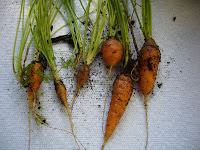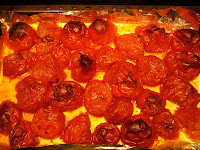


You might also like:
November native plant of the month: Doll's Eyes
October native plant of the month: Sugar Maple
September native plant of the month: Blueberry
August native plant of the month: Joe Pye Weed
Local food, native plants, and the musings of a Maryland gardener.



3. Animal, Vegetable, Miracle by Barbara Kingsolver and Plenty by Alisa Smith and J. B. Mackinnon. These two book cover somewhat the same territory. In both, the authors try to live for a year eating only local food. In the Kingsolver book, her family raises a good portion of their food. In Plenty, an urban couple in Vancouver tries to source all of their food within 100 miles of their house. I was inspired by both of these books.
4. Fresh Food Fast by Peter Berley and Vegetarian Suppers by Deborah Madison. Once you grow - or buy - all of these vegetables, you need to know how to cook them. These are both great cookbooks for cooking seasonal vegetables. I am not a vegetarian, but I love these vegetarian cook books.
5. Food Matters by Mark Bittman. I have not read this one, but it is on my list. This is a mix of The Omnivore's Dilemma and a cookbook. Mark Bittman is a food writer for the New York Times, and in this book, mixes his own personal food conversion (and weight loss) with recipes.
What have I missed? What books on local food or vegetable gardening do you refer to again and again?




This weekend, I harvested my last eggplants and peppers. I still have two butternut squash on the vine, and some chard that may continue to produce, but I am ready to do the final tally for my garden.
From my 32 square foot garden (two 4x4 raised beds) I harvested:
*I am too lazy to weigh my produce, so I either count by item (if large) or by "serving" meaning the amount needed for a side dish for one person.
Also in my square foot garden, I had tons of sage and oregano, and a bit of basil.
In addition, I also harvested 4 servings of snow peas from pots on my deck.
Not bad for a small garden. I am getting better at planting a series of crops in the same space, although there is still room for improvement. I tried to put a crop of beans in after the snow peas, but waited too long. As a result I got very few beans in the pots on my deck.
For more on my harvest, check out what worked and what didn't in my vegetable garden this year.
What was your harvest like this year?


Photo credit: Muffet

Overall, it was a pretty good year. Although I want everything to flourish, part of the fun is experimenting with new things. I will definitely try the carrots again, but unless I plan to be around to water it, I will probably skip the Fall crops.
What were the disappointments in your garden?



How about you? What worked in your garden?
 Of course, it happens when you start to feel smug....so sure you are immune. After all, my tomatoes had been doing so well - the best year ever.
Of course, it happens when you start to feel smug....so sure you are immune. After all, my tomatoes had been doing so well - the best year ever.

"They have the common touch. They're chummy with evergreens, comfy among flowers, at ease in tall grass, as much at home in a foundation planting as a hedgerow. No one could ask for a less demanding friend. Blueberries are happy in full sun, relaxed in dappled shade, uncomplaining of drought, but just as pleased to grow in damp. No blueberry pal of mine has ever asked for pruning, wanted my protection from pests or weather, or even expressed the slightest appetite for food."

Dorset Farmer’s Market - our first stop of the day was at the farmer’s market in Dorset. I know, every town has a farmer’s market, but every market has a different mix of products and has its own personality. This one had a great small town vibe. Lots of people at the market knew each other, yet people were also very friendly to strangers as well. One vendor even brought their pet baby goat. This goat, who was blind, was obviously a regular at the market. A man selling apples was giving out samples of a sweet crab apple (I think it is called a Hawthorne crab apple). Wonderful flavor.
At our three stops we bought:

That night, we had a great dinner using all of these local products. Although I love the fact that our purchases support local farmers, my main motivation in buying all the food was the fun of sampling the local food of the area we were visiting.
At the recent Native Plant Seminar at The Irvine Nature Center, I attended an afternoon session entitled “The Woods in Your Backyard”. The purpose of the seminar was to teach homeowners with relatively small lots how to manage the woodlands on their property.
In Maryland, 78% of all woodlands are owned by private landowners, and 80% of those holdings are under 10 acres. So what we do in our yards can have a significant impact on the health of the eco-system in the state.
Here are three important things that we can each have in our backyard, no matter how small:
Mast trees – These are trees that produce fruit or nuts to feed local wildlife. Examples are oak trees, hickory, dogwood, or black cherry.
Snags – Unless they are a hazard, don’t cut those dead trees down! Standing dead trees provide food and habitat for many species, including woodpeckers.
Brush piles – These piles provide shelter for small mammals and other wildlife. One important thing to note – the base of the pile should be larger items (tree branches, for example) and then be covered with smaller pieces. This creates nooks for small mammals and birds.
For some great online resources go to The Woods in Your Backyard website.
 There are at least three kinds of invasive knotweeds – Bohemian, giant, and Japanese knotweed. (latin names: Polygonum x bohemicum, P. cuspidatum, P. sachalinense). All have similar characteristics – they are incredibly invasive and incredibly hard to kill.
There are at least three kinds of invasive knotweeds – Bohemian, giant, and Japanese knotweed. (latin names: Polygonum x bohemicum, P. cuspidatum, P. sachalinense). All have similar characteristics – they are incredibly invasive and incredibly hard to kill.














And did I mention it is free? I think it will be a great event - here are the details of the tour and more information on bay-wise gardening.
 Next is a tomato onion tart that we took to a neighbor's house for a mid-week potluck. It was a huge hit! The tomato and basil are from our garden.
Next is a tomato onion tart that we took to a neighbor's house for a mid-week potluck. It was a huge hit! The tomato and basil are from our garden. We also took a cucumber salad to the potluck. Unfortuantely, I don't have link to the recipe, but it is from the cookbook, Fresh Food Fast by Peter Berley
We also took a cucumber salad to the potluck. Unfortuantely, I don't have link to the recipe, but it is from the cookbook, Fresh Food Fast by Peter Berley
And finally (do you sense a tomato theme in this post?), we made gazpacho. No specific recipe here - we started with a recipe from Jaleo, a great restuarant in D.C. and then improvised from there. Terrific!

 Put the jar in the refrigerator for 2 days and give them a try. They will keep for at least a week. Let me know how you like them!
Put the jar in the refrigerator for 2 days and give them a try. They will keep for at least a week. Let me know how you like them! I want to start profiling native plants that are great for use in a backyard and also have wildlife value. August isn't the best month to start such a profile - there are few plants that shine in the dog days of August.
I want to start profiling native plants that are great for use in a backyard and also have wildlife value. August isn't the best month to start such a profile - there are few plants that shine in the dog days of August.